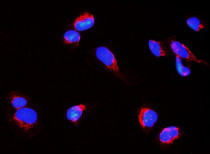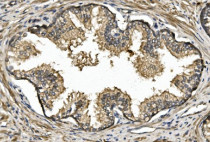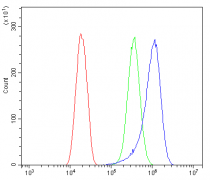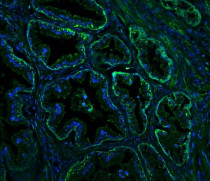ARG43068
anti-RTN4 / Nogo A antibody
anti-RTN4 / Nogo A antibody for Flow cytometry,ICC/IF,IHC-Formalin-fixed paraffin-embedded sections,Western blot and Human
Overview
| Product Description | Rabbit Polyclonal antibody recognizes RTN4 / Nogo A |
|---|---|
| Tested Reactivity | Hu |
| Tested Application | FACS, ICC/IF, IHC-P, WB |
| Host | Rabbit |
| Clonality | Polyclonal |
| Isotype | IgG |
| Target Name | RTN4 / Nogo A |
| Antigen Species | Human |
| Immunogen | Synthetic peptide corresponding to a sequence of Human RTN4 / Nogo A. (VSNNILHNQQELPTALTKLV) |
| Conjugation | Un-conjugated |
| Alternate Names | Foocen; NSP-CL; Nogo protein; Nbla10545; ASY; Reticulon-5; Reticulon-4; Neuroendocrine-specific protein C homolog; NSP; Nogo-B; Nogo-C; Neuroendocrine-specific protein; RTN-x; Nbla00271; Neurite outgrowth inhibitor; RTN4-A; RTN4-C; NOGO-A; RTN-X; NOGOC; NOGO; NI220/250; RTN4-B1; RTN4-B2 |
Application Instructions
| Application Suggestion |
|
||||||||||
|---|---|---|---|---|---|---|---|---|---|---|---|
| Application Note | IHC-P: Antigen Retrieval: Heat mediation was performed in EDTA buffer (pH 8.0). * The dilutions indicate recommended starting dilutions and the optimal dilutions or concentrations should be determined by the scientist. |
Properties
| Form | Liquid |
|---|---|
| Purification | Affinity purification with immunogen. |
| Buffer | 0.2% Na2HPO4, 0.9% NaCl, 0.01% Sodium azide and 4% Trehalose. |
| Preservative | 0.01% Sodium azide |
| Stabilizer | 4% Trehalose |
| Concentration | 0.5 mg/ml |
| Storage Instruction | For continuous use, store undiluted antibody at 2-8°C for up to a week. For long-term storage, aliquot and store at -20°C or below. Storage in frost free freezers is not recommended. Avoid repeated freeze/thaw cycles. Suggest spin the vial prior to opening. The antibody solution should be gently mixed before use. |
| Note | For laboratory research only, not for drug, diagnostic or other use. |
Bioinformation
| Database Links | |
|---|---|
| Gene Symbol | RTN4 |
| Gene Full Name | reticulon 4 |
| Background | This gene belongs to the family of reticulon encoding genes. Reticulons are associated with the endoplasmic reticulum, and are involved in neuroendocrine secretion or in membrane trafficking in neuroendocrine cells. The product of this gene is a potent neurite outgrowth inhibitor which may also help block the regeneration of the central nervous system in higher vertebrates. Alternatively spliced transcript variants derived both from differential splicing and differential promoter usage and encoding different isoforms have been identified. [provided by RefSeq, Jul 2008] |
| Function | Required to induce the formation and stabilization of endoplasmic reticulum (ER) tubules (PubMed:27619977, PubMed:25612671, PubMed:24262037). They regulate membrane morphogenesis in the ER by promoting tubular ER production (PubMed:27619977, PubMed:25612671, PubMed:24262037, PubMed:27786289). They influence nuclear envelope expansion, nuclear pore complex formation and proper localization of inner nuclear membrane proteins (PubMed:26906412). However each isoform have specific functions mainly depending on their tissue expression specificities (Probable). [Isoform A]: Developmental neurite growth regulatory factor with a role as a negative regulator of axon-axon adhesion and growth, and as a facilitator of neurite branching. Regulates neurite fasciculation, branching and extension in the developing nervous system. Involved in down-regulation of growth, stabilization of wiring and restriction of plasticity in the adult CNS (PubMed:10667797, PubMed:11201742). Regulates the radial migration of cortical neurons via an RTN4R-LINGO1 containing receptor complex (By similarity). Acts as a negative regulator of central nervous system angiogenesis. Inhibits spreading, migration and sprouting of primary brain microvascular endothelial cells (MVECs). Also induces the retraction of MVECs lamellipodia and filopodia in a ROCK pathway-dependent manner (By similarity). [Isoform B]: Mainly function in endothelial cells and vascular smooth muscle cells, is also involved in immune system regulation (Probable). Modulator of vascular remodeling, promotes the migration of endothelial cells but inhibits the migration of vascular smooth muscle cells. Regulates endothelial sphingolipid biosynthesis with direct effects on vascular function and blood pressure. Inhibits serine palmitoyltransferase, SPTLC1, the rate-limiting enzyme of the novo sphingolipid biosynthetic pathway, thereby controlling production of endothelial sphingosine-1-phosphate (S1P). Required to promote macrophage homing and functions such as cytokine/chemokine gene expression involved in angiogenesis, arteriogenesis and tissue repair. Mediates ICAM1 induced transendothelial migration of leukocytes such as monocytes and neutrophils and acute inflammation. Necessary for immune responses triggered by nucleic acid sensing TLRs, such as TLR9, is required for proper TLR9 location to endolysosomes. Also involved in immune response to LPS. Plays a role in liver regeneration through the modulation of hepatocytes proliferation (By similarity). Reduces the anti-apoptotic activity of Bcl-xl and Bcl-2. This is likely consecutive to their change in subcellular location, from the mitochondria to the endoplasmic reticulum, after binding and sequestration (PubMed:11126360). With isoform C, inhibits BACE1 activity and amyloid precursor protein processing (PubMed:16965550). [Isoform C]: Regulates cardiomyocyte apoptosis upon hypoxic conditions (By similarity). With isoform B, inhibits BACE1 activity and amyloid precursor protein processing (PubMed:16965550). [UniProt] |
| Cellular Localization | Endoplasmic reticulum membrane; Multi-pass membrane protein. Note=Anchored to the membrane of the endoplasmic reticulum (ER) through 2 putative transmembrane domains. Localizes throughout the ER tubular network (PubMed:27619977). Co-localizes with TMEM33 at the ER sheets. [UniProt] |
| Calculated MW | 130 kDa |
Images (5) Click the Picture to Zoom In
-
ARG43068 anti-RTN4 / Nogo A antibody ICC/IF image
Immunofluorescence: U2OS cells were blocked with 10% goat serum and then stained with ARG43068 anti-RTN4 / Nogo A antibody (red) at 4 µg/ml dilution, overnight at 4°C. DAPI (blue) for nuclear staining.
-
ARG43068 anti-RTN4 / Nogo A antibody IHC-P image
Immunohistochemistry: Paraffin-embedded Human prostatic cancer tissue. Antigen Retrieval: Heat mediation was performed in EDTA buffer (pH 8.0). The tissue section was blocked with 10% goat serum. The tissue section was then stained with ARG43068 anti-RTN4 / Nogo A antibody at 1 µg/ml dilution, overnight at 4°C.
-
ARG43068 anti-RTN4 / Nogo A antibody WB image
Western blot: 50 µg of sample under reducing conditions. U-87MG and SH-SY5Y whole cell lysates stained with ARG43068 anti-RTN4 / Nogo A antibody at 0.25 µg/ml dilution, overnight at 4°C.
-
ARG43068 anti-RTN4 / Nogo A antibody FACS image
Flow Cytometry: SiHa cells were blocked with 10% normal goat serum and then stained with ARG43068 anti-RTN4 / Nogo A antibody (blue) at 1 µg/10^6 cells for 30 min at 20°C, followed by incubation with DyLight®488 labelled secondary antibody. Isotype control antibody (green) was rabbit IgG (1 µg/10^6 cells) used under the same conditions. Unlabelled sample (red) was also used as a control.
-
ARG43068 anti-RTN4 / Nogo A antibody IHC-P image
Immunohistochemistry: Paraffin-embedded Human prostatic cancer tissue. Antigen Retrieval: Heat mediation was performed in EDTA buffer (pH 8.0). The tissue section was blocked with 10% goat serum. The tissue section was then stained with ARG43068 anti-RTN4 / Nogo A antibody at 4 µg/ml dilution, overnight at 4°C. The section was counterstained with DAPI (blue).










